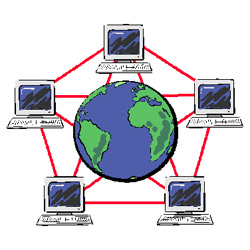Remote access is a connection that is made between two or more systems located in geographically different places by connecting them through a computer network (LAN, WAN), such as through the Internet, allowing complete control of the systems remotely. The system used to perform the operations is usually called the client, while the one being controlled is usually called the server.
The simplest and most immediate solution to remotely control a system is to have an Internet connection with a public (even if not static) IP address on the remote system. In this way, it will be sufficient to publish the TCP / IP ports to be reached through an appropriate configuration of the NAT (or port forwarding) rules on the Internet connection router. This solution, although simple, has some disadvantages that can be summarized as follows:
- It is not always possible to have a public IP address on the system (see for example LTE wireless connections)
- You must have full access to the router, which is not always possible as the router is often on loan for use by the manager.
- It is necessary to know in advance which ports are to be published, finding themselves in difficulty when activating a new service that uses other ports.
- The traffic is not encrypted, we only rely on the security offered by the system to be controlled.
Peer-to-peer
The use of a peer-to-peer communication service (abbreviated to P2P) allows to overcome all these disadvantages, it is a network architecture in which the nodes are not hierarchized only in the form of client or server but also in the form of equivalent or "peer" nodes, being able to act at the same time as client and server towards the other nodes of the network.
There are many software on the market that manage peer-to-peer communications between different systems even on NATtate networks, therefore without a public IP address, allowing interconnection between different systems as if physically belonging to the same physical network.

Software for SlimLine Raspberry
Systems SlimLIne Raspberry use the Raspbian operating system and there are several programs that allow you to create peer-to-peer connections between your PC and the module SlimLine, but not only is it also possible to interconnect different systems with each other SlimLine each belonging to different networks even under NAT. It is not my intention to list all the programs available, just do a search on the Internet, below I indicate those programs that I happened to use and that I found particularly efficient and simple to use.
Zero Tier
With the free subscription, 50 devices can be connected to each other, to which an administrator can assign unique IP addresses within the ZeroTier network. The connection is made with an encrypted protocol and each device can connect with any other device in the network. By installing the program on the device or on the PC, a network interface connected to the ZeroTier network is added. It is possible to create several independent networks, each network is identified with a NetworkID unique. To install it on Raspberry from the terminal, execute the commands:
curl -s https://install.zerotier.com/ | sudo bash Esegue l'installazione del servizio sudo zerotier-cli join [NetworkID] Connette il sistema alla rete indicata sudo zerotier-cli status Visualizza lo stato della connessione sudo touch /var/lib/zerotier-one/networks.d/[Network ID].conf Avvia automaticamente il servizio alla accensione
When checking the connection status, an error like “ACCESS_DENIED” is normal, since the client must be enabled, if the network is private, the administrator from the ZeroTier portal must enable the connection. When the client is connected to the network, the response is "ONLINE". For installation on a PC, please refer to the numerous guides available online.
